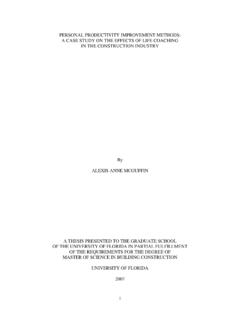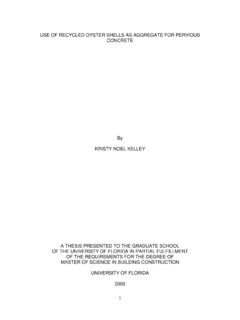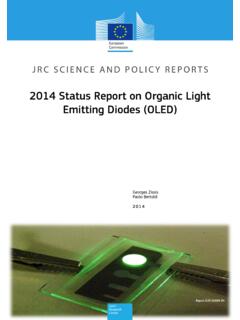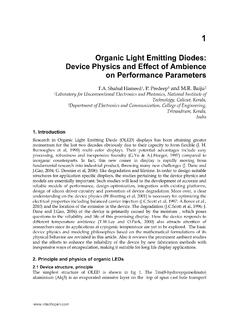Transcription of ORGANIC LIGHT-EMITTING DIODES AND RELATED HYBRID …
1 1 ORGANIC LIGHT-EMITTING DIODES AND RELATED HYBRID LIGHT-EMITTING DEVICES By DONG WOO SONG A DISSERTATION PRESENTED TO THE GRADUATE SCHOOL OF THE UNIVERSITY OF FLORIDA IN PARTIAL FULFILLMENT OF THE REQUIREMENTS FOR THE DEGREE OF DOCTOR OF PHILOSOPHY UNIVERSITY OF FLORIDA 2011 2 2011 Dong Woo Song 3 To my family 4 ACKNOWLEDGMENTS First of all, I would like to appreciate my advisor, Dr. Franky So for guiding me during full period of my cource. His plenty of advices have stimulated me to widen my sight, especially for industrial perspective. I am also thankful to Dr. Jiangeng Xue, Dr. Stephen Pearton, Dr. David Norton, Dr. Brent Gila and Dr. Andrew Rinzler for agreeing to serve on my supervisory committee and/or for sharing their time. I thank my colleagues in Dr. So s group: Kaushik Roy Chouhury, Jiyon Song, Subbiah Jegadesan, Chi Hang Cheung, Lei Qian, Wonhoe Koo, Sai-Wing Tsang, Jaewon Lee, Neetu Chopra, Galileo Sarasqueta, Jong Hyuk Yoon, Alok Gupta, Cephas Small, Michael Hartel, Song Chen, Pieter de Somer, Verena Giese, Jae Woong Lee, Wooram Youn, Chaoyu Xiang, Jesse Manders, Fred Steffy, Nikhil Bhandari, Francisco Delgado, Tzung-Han Lai, Chieh-Chun Chaing, Shuyi Liu and Jiho Ryu.
2 I would like to express my special thanks to Do Young Kim as not only a colleague but also a mentor during my obscure course. I acknowledge the contribution of the following colleagues on my research works: Wooram Youn, Chaoyu Xiang and Cephas Small for OLED works, Kaushik Roy Choudhury for HYBRID NIR-LED works, and Do Young Kim, Kaushik Roy Choudhury, Jae Woong Lee, Galileo Sarasqueta for up-conversion device works. I also acknowledge the financial support of Department of Energy Solid State Lighting program, Defense Advanced Research Projects Agency Extreme light Sources program and Nanoholdings for my research activities. I also thank my Korean friends in MSE: Sanghyun Eom, Kangtaek Lee, Byungwook Lee, Sangjoon Lee, Jinwoo Kwak, Sungwon Choi, Hyoungjun Park, Jaeseok Lee, Seungyong Son, Wantae Lim, Junghoon Jang, Chanwoo Lee, Dongjo Oh, 5 Myounghwan Oh, Donghyun Kim, Jihoon Choi, Minki Hong, Jungbae Lee, Sungwook Min, Jinhyung Lee, Seunghwan Yeo, Chinsung Park, Hyuksoo Han and Kwangwon Lee.
3 I would like to express my special thanks to Seonhoo Kim, Kyeongwon Kim and Inkook Jun with sincere friendship for long years. I appreciate Korean Buddhist Association members for sharing in religious view and leisure time: Sooyeon Kim, Chunghwan Sung, Youngjae Song, Sangeun Oh, Hyeongjeen Jeen, Yoojung Park, Yoonjung Lim, Jaejin Lee and Kyungpyo Hong. I would like to express my best gratitude and love to my family. My parents have supported me physically and spiritually. They lead me to walk on the right path during my whole life. My sister has taken the lead of me as a scientist and a mentor as well, and thus I started to be a scientist. I truly appreciate my parents-in-law for giving me a great deal of support and sincere cheers. I am genuinely grateful to my lovely wife, Sora Lee. After I met her, my life was changed and filled with joy and love. I would like to express my love to my baby son, Yoohyun Henry Song. No one can live alone.
4 I get indebted by the Fourfold Grace of Heaven and Earth, Parents, Fellow Beings and Laws and I shall enshrine Il-Won-Sang as my object of faith and my model of practice. 6 TABLE OF CONTENTS page ACKNOWLEDGMENTS .. 4 LIST OF TABLES .. 9 LIST OF FIGURES .. 10 LIST OF ABBREVIATIONS .. 14 ABSTRACT .. 16 CHAPTER 1 INTRODUCTION .. 18 ORGANIC LIGHT-EMITTING DIODES .. 18 Advantages and Disadvantages of ORGANIC Materials .. 18 Applications of OLEDs .. 19 Display applications .. 20 Lighting applications .. 21 Basic Concepts for OLED Lighting .. 22 Basics in colorimetry .. 22 Basics in device 25 Physics in ORGANIC LIGHT-EMITTING DIODES .. 26 Electronic structures .. 26 Charge transport .. 27 Excitons and intermolecular exciton energy transfer .. 28 Fluorescence and phosphorescence .. 29 Colloidal Quantum Dot-Based HYBRID LIGHT-EMITTING DIODES .. 30 State of the Art HYBRID LEDs .. 30 Visible- emitting HYBRID LEDs.
5 30 Infrared- emitting HYBRID LEDs .. 32 Colloidal Quantum Dots .. 33 Synthesis of colloidal quantum dots .. 33 Optical properties of colloidal quantum dots .. 34 ORGANIC and HYBRID Photodetectors and ORGANIC Up-Conversion Devices .. 34 Visible ORGANIC Photodetectors .. 34 Infrared ORGANIC Photodetectors .. 35 Colloidal Quantum Dot Based HYBRID Photodetectors .. 36 ORGANIC Up-Conversion Devices .. 38 Dissertation Organization .. 39 2 WHITE PHOSPHORESCENT ORGANIC LIGHT-EMITTING DIODES .. 47 Background and Motivation .. 47 7 Experimental Details .. 48 Results and Discussion .. 49 Red-Blue Double Emissive Layer White OLEDs .. 49 Red-Blue-Green Triple Emissive Layer and Red-Blue-Blue-Green Quadruple Emissive Layer White OLEDs .. 50 Emission Mechanism in Multiple Emissive Layer White OLEDs .. 52 Summary .. 55 3 GREEN PHOSPHORESCENT STACKED ORGANIC LIGHT-EMITTING DIODES .. 64 Background and Motivation .. 64 Experimental Details.
6 64 Results and Discussion .. 65 Study of Charge generation Units in Stacked ORGANIC LIGHT-EMITTING DIODES .. 65 Single and Double Stacked ORGANIC LIGHT-EMITTING DIODES .. 68 Summary .. 71 4 POLYMER-COLLOIDAL QUANTUM DOT HYBRID NEAR INFRARED LIGHT-EMITTING DEVICES .. 80 Background and Motivation .. 80 Experimental Details .. 80 Synthesis and Processing of PbSe Colloidal Quantum Dots .. 80 Device Fabrication .. 81 Characterization of PbSe Colloidal Quantum Dots and HYBRID LIGHT-EMITTING Devices .. 81 Results and Discussion .. 82 PbSe Colloidal Quantum Dots .. 82 HYBRID Multilayer QD LEDs .. 82 HYBRID Polymer-QD LEDs .. 84 Effect of QD concentration .. 85 Effect of active layer thickness .. 87 Summary .. 88 5 NEAR INFRARED-TO-GREEN ORGANIC UP-CONVERSION DEVICES .. 97 Background and Motivation .. 97 Experimental Details .. 98 Results and Discussion .. 99 Control Up-Conversion Device .. 99 Effect of Hole Blocking Layer.
7 100 Effect of Electron Injection Layer .. 102 Dependence of Optical Power Density .. 103 Summary .. 104 8 6 QUANTUM DOT BASED NEAR INFRARED-TO-GREEN HYBRID UP-CONVERSION DEVICES .. 112 Background and Motivation .. 112 Experimental Details .. 113 Results and Discussion .. 115 Summary .. 120 7 CONCLUSION .. 127 APPENDIX : MOLECULAR STRUCTURES OF ORGANIC MATERIALS USED IN THIS DISSERTATION .. 129 LIST OF REFERENCES .. 133 BIOGRAPHICAL SKETCH .. 138 9 LIST OF TABLES Table page 5-1 Materials used in this work for hole blocking layers with their respective HOMO and LUMO energies.. 105 5-2 Dark-current-induced turn-on voltage and maximum operating photon-to-photon conversion efficiency with various hole injection structures.. 105 10 LIST OF FIGURES Figure page 1-1 Various display applications with OLEDs .. 40 1-2 Forecast of AMOLED capacity and year-by-year growth rate .. 40 1-3 Comparison of the key-performance parameters of WOLEDs relative to incandescent lamps, fluorescent tubes and inorganic white LEDs.
8 41 1-4 Various luminaires with OLEDs panels demonstrated by OLED lighting companies .. 42 1-5 Comparison of eye sensitivity functions for the photopic and scotopic vision regime .. 42 1-6 CIE (1931) and CIE (1978) xyz color matching functions (CMFs). Note that the CIE 1931 CMF is the currently valid official standard.. 43 1-7 CIE 1931 (x, y) chromaticity diagram. White light is located in the center. Also shown are the regions of distinct colors .. 43 1-8 Schematic drawing of electronic states of ORGANIC semiconductors .. 44 1-9 Schematic drawing of non-radiative inter-molecular energy transfer processes.. 44 1-10 Schematic illustration of Jablonski energy diagram .. 45 1-11 Schematic illustration of the preparation of monodisperse QDs based on La Mer model .. 45 1-12 Schematic comparison of quantization of density of states .. 46 2-1 Energy level diagram of materials used in this study.. 56 2-2 Device structure and electroluminescence spectra of R-B double emissive layer white OLEDs: A) schematic diagram of the device structure and B) EL spectra of double emissive layer white OLEDs.
9 56 2-3 L-I-V characteristics and efficiencies of double emissive layer white OLEDs .. 57 2-4 Device structure and electroluminescence spectra of R-B-G triple emissive layer white OLEDs.. 58 2-5 Device structure and electroluminescence spectra of R-B-B-G quadruple emissive layer white OLEDs .. 58 11 2-6 Electroluminescence spectra of monochromatic and white OLEDs and efficiencies of white OLEDs .. 59 2-7 Device structure and electroluminescence spectra of devices for the investigation of emission mechanism .. 60 2-8 Schematic illustration of emission mechanism in R-B-B-G quadruple emissive layer WOLEDs.. 61 2-9 Comparison of I-V characteristics and efficiencies of double and triple emissive layer OLEDs .. 62 2-10 Device structure, EL spectra and efficiencies of R-B-G triple emissive layer white OLEDs with balanced emission .. 63 3-1 Schematic energy diagram of charge generation devices with different presence of the interconnecting unit.
10 72 3-2 Device structure and I-V characteristics of devices with different presence of interconnecting units .. 73 3-3 Proposed schematic energy band diagram of the charge generation interconnecting unit.. 74 3-4 Current densities of charge generation devices as a function of voltage with various Cs2CO3 doping concentration in a BPhen electron transporting layer.. 74 3-5 Current densities of charge generation devices as a function of voltage with and without a thin Al interlayer.. 75 3-6 Luminance plots as a function of voltage of double stacked green phosphorescent OLEDs with different charge generation interfaces.. 75 3-7 Current density plots as a function of voltage of NPB and TAPC hole only devices .. 76 3-8 Schematic device structures of double stacked phosphorescent OLEDs.. 77 3-9 L-I-V characteristics and efficiencies of single and double stacked green phosphorescent OLEDs .. 78 3-10 L-I-V characteristics and efficiencies of single and double stacked green phosphorescent OLEDs with the modified device structure.



















